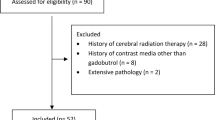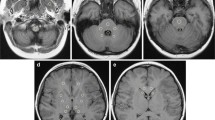Abstract
Purpose
To investigate if application of macrocyclic gadolinium-based contrast agents in volunteers is associated with neuronal deposition detected by magnetic resonance imaging in a 5-year longitudinal survey.
Materials and methods
Three hundred eighty-seven volunteers who participated in a population-based study were enrolled. Subjects underwent plain T1-weighted brain MRI at baseline and 5 years later with identical sequence parameters. At baseline, 271 participants additionally received intravenous injection of the macrocyclic contrast agent gadobutrol (1.5 mmol/kg). A control group including 116 subjects received no contrast agent. Relative signal intensities of thalamus, pallidum, pons and dentate nucleus were compared at baseline and follow-up.
Results
No difference in relative signal intensities was observed between contrast group (thalamus, p = 0.865; pallidum, p = 0.263; pons, p = 0.533; dentate nucleus, p = 0.396) and control group (thalamus, p = 0.683; pallidum; p = 0.970; pons, p = 0.773; dentate nucleus, p = 0.232) at both times. Comparison between both groups revealed no significant differences in relative signal intensities (thalamus, p = 0.413; pallidum, p = 0.653; pons, p = 0.460; dentate nucleus, p = 0.751). The study showed no significant change in globus pallidus-to-thalamus or dentate nucleus-to-pons ratios.
Conclusions
Five years after administration of a 1.5-fold dose gadobutrol to normal subjects, signal intensity of thalamus, pallidum, pons and dentate nucleus did not differ from participants who had not received gadobutrol.
Key Points
• Gadobutrol does not lead to neuronal signal alterations after 5 years.
• Neuronal deposition of macrocyclic contrast agent could not be confirmed.
• Macrocyclic contrast agents in a proven dosage are safe.




Similar content being viewed by others
References
Felix R, Schorner W, Laniado M et al (1985) Brain tumors: MR imaging with gadolinium-DTPA. Radiology 156:681–688
Niendorf HP, Felix R, Laniado M, Schorner W, Kornmesser W, Claussen C (1986) Magnetic resonance imaging of intracranial tumors using gadolinium-DTPA. Initial experience with fast imaging. Acta Radiol Suppl 369:561–563
Claussen C, Laniado M, Schorner W et al (1985) Gadolinium-DTPA in MR imaging of glioblastomas and intracranial metastases. AJNR Am J Neuroradiol 6:669–674
Weinmann HJ, Brasch RC, Press WR, Wesbey GE (1984) Characteristics of gadolinium-DTPA complex: a potential NMR contrast agent. AJR Am J Roentgenol 142:619–624
Port M, Idee JM, Medina C, Robic C, Sabatou M, Corot C (2008) Efficiency, thermodynamic and kinetic stability of marketed gadolinium chelates and their possible clinical consequences: a critical review. Biometals 21:469–490
Frenzel T, Lengsfeld P, Schirmer H, Hutter J, Weinmann HJ (2008) Stability of gadolinium-based magnetic resonance imaging contrast agents in human serum at 37 degrees C. Investig Radiol 43:817–828
Hao D, Ai T, Goerner F, Hu X, Runge VM, Tweedle M (2012) MRI contrast agents: basic chemistry and safety. J Magn Reson Imaging 36:1060–1071
Grobner T (2006) Gadolinium--a specific trigger for the development of nephrogenic fibrosing dermopathy and nephrogenic systemic fibrosis? Nephrol Dial Transplant 21:1104–1108
Marckmann P, Skov L, Rossen K et al (2006) Nephrogenic systemic fibrosis: suspected causative role of gadodiamide used for contrast-enhanced magnetic resonance imaging. J Am Soc Nephrol 17:2359–2362
Kanal E, Tweedle MF (2015) Residual or retained gadolinium: practical implications for radiologists and our patients. Radiology 275:630–634
Kanda T, Ishii K, Kawaguchi H, Kitajima K, Takenaka D (2014) High signal intensity in the dentate nucleus and globus pallidus on unenhanced T1-weighted MR images: relationship with increasing cumulative dose of a gadolinium-based contrast material. Radiology 270:834–841
Kanda T, Fukusato T, Matsuda M et al (2015) Gadolinium-based contrast agent accumulates in the brain even in subjects without severe renal dysfunction: evaluation of autopsy brain specimens with inductively coupled plasma mass spectroscopy. Radiology 276:228–232
Errante Y, Cirimele V, Mallio CA, Di Lazzaro V, Zobel BB, Quattrocchi CC (2014) Progressive increase of T1 signal intensity of the dentate nucleus on unenhanced magnetic resonance images is associated with cumulative doses of intravenously administered gadodiamide in patients with normal renal function, suggesting dechelation. Investig Radiol 49:685–690
McDonald RJ, McDonald JS, Kallmes DF et al (2015) Intracranial gadolinium deposition after contrast-enhanced MR imaging. Radiology 275:772–782
Volzke H, Alte D, Schmidt CO et al (2011) Cohort profile: the study of health in Pomerania. Int J Epidemiol 40:294–307
John U, Greiner B, Hensel E et al (2001) Study of health in pomerania (SHIP): a health examination survey in an east German region: objectives and design. Soz Praventivmed 46:186–194
Hegenscheid K, Kuhn JP, Volzke H, Biffar R, Hosten N, Puls R (2009) Whole-body magnetic resonance imaging of healthy volunteers: pilot study results from the population-based SHIP study. Röfo 181:748–759
Radbruch A, Weberling LD, Kieslich PJ et al (2015) Gadolinium retention in the dentate nucleus and globus pallidus is dependent on the class of contrast agent. Radiology 275:783–791
Kanda T, Osawa M, Oba H et al (2015) High signal intensity in dentate nucleus on unenhanced T1-weighted MR images: association with linear versus macrocyclic gadolinium chelate administration. Radiology 275:803–809
Radbruch A, Weberling LD, Kieslich PJ et al (2015) High-signal intensity in the dentate nucleus and globus pallidus on unenhanced T1-weighted images: evaluation of the macrocyclic gadolinium-based contrast agent gadobutrol. Investig Radiol 50:805–810
Kasahara S, Miki Y, Kanagaki M et al (2011) Hyperintense dentate nucleus on unenhanced T1-weighted MR images is associated with a history of brain irradiation. Radiology 258:222–228
Roccatagliata L, Vuolo L, Bonzano L, Pichiecchio A, Mancardi GL (2009) Multiple sclerosis: hyperintense dentate nucleus on unenhanced T1-weighted MR images is associated with the secondary progressive subtype. Radiology 251:503–510
Lai PH, Chen C, Liang HL, Pan HB (1999) Hyperintense basal ganglia on T1-weighted MR imaging. AJR Am J Roentgenol 172:1109–1115
Rovira A, Alonso J, Cordoba J (2008) MR imaging findings in hepatic encephalopathy. AJNR Am J Neuroradiol 29:1612–1621
Oikonomou A, Chatzistefanou A, Zezos P, Mintzopoulou P, Vadikolias K, Prassopoulos P (2012) Basal ganglia hyperintensity on T1-weighted MRI in Rendu-Osler-Weber disease. J Magn Reson Imaging 35:426–430
Valdes Hernandez Mdel C, Maconick LC, Tan EM, Wardlaw JM (2012) Identification of mineral deposits in the brain on radiological images: a systematic review. Eur Radiol 22:2371–2381
Shin YC, Kim E, Cheong HK et al (2007) High signal intensity on magnetic resonance imaging as a predictor of neurobehavioral performance of workers exposed to manganese. Neurotoxicology 28:257–262
da Silva CJ, da Rocha AJ, Jeronymo S et al (2007) A preliminary study revealing a new association in patients undergoing maintenance hemodialysis: manganism symptoms and T1 hyperintense changes in the basal ganglia. AJNR Am J Neuroradiol 28:1474–1479
Martin-Duverneuil N, Idbaih A, Hoang-Xuan K et al (2006) MRI features of neurodegenerative Langerhans cell histiocytosis. Eur Radiol 16:2074–2082
Acknowledgments
The scientific guarantor of this publication is MD J.-P. Kühn. The authors of this manuscript declare no relationships with any companies, whose products or services may be related to the subject matter of the article. This study has received funding by the Federal Ministry of Education and Research (01ZZ9603, 01ZZ0103, 01ZZ0403, 01ZZ0701, 03ZIK012), the Ministry of Cultural Affairs as well as the Social Ministry of the Federal State of Mecklenburg-West Pomerania. Whole-body MR imaging was supported by a joint grant from Siemens Healthcare, Erlangen, Germany, and the Federal State of Mecklenburg-West Pomerania. The University of Greifswald is a member of the ‘Center of Knowledge Interchange’ program of Siemens AG. Contrast-enhanced MRI research is part of the entire whole-body MRI study and was supported by Bayer Healthcare. One of the authors has significant statistical expertise. Institutional Review Board approval was obtained. Written informed consent was obtained from all subjects (patients) in this study. Some study subjects or cohorts have been previously reported in the context of publications made during the Study of Health in Pomerania, a prospective population-based cohort study in a defined region in Northeast Germany. Methodology: retrospective, observational, performed at one institution.
Author information
Authors and Affiliations
Corresponding author
Additional information
An erratum to this article is available at http://dx.doi.org/10.1007/s00330-016-4472-6.
Rights and permissions
About this article
Cite this article
Kromrey, ML., Liedtke, K.R., Ittermann, T. et al. Intravenous injection of gadobutrol in an epidemiological study group did not lead to a difference in relative signal intensities of certain brain structures after 5 years. Eur Radiol 27, 772–777 (2017). https://doi.org/10.1007/s00330-016-4418-z
Received:
Revised:
Accepted:
Published:
Issue Date:
DOI: https://doi.org/10.1007/s00330-016-4418-z




